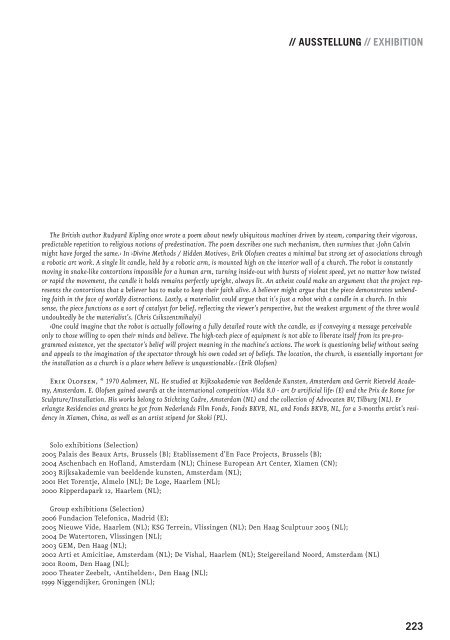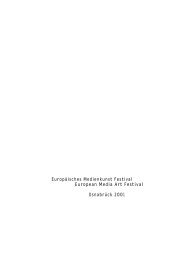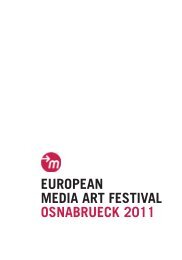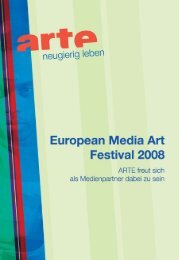You also want an ePaper? Increase the reach of your titles
YUMPU automatically turns print PDFs into web optimized ePapers that Google loves.
AUSSTELLUNG // EXHIBITION<br />
The British author Rudyard Kipling once wrote a poem about newly ubiquitous machines driven by steam, comparing their vigorous,<br />
predictable repetition to religious notions of predestination. The poem describes one such mechanism, then surmises that ›John Calvin<br />
might have forged the same.‹ In ›Divine Methods / Hidden Motives‹, Erik Olofsen creates a minimal but strong set of associations through<br />
a robotic art work. A single lit candle, held by a robotic arm, is mounted high on the interior wall of a church. The robot is constantly<br />
moving in snake-like contortions impossible for a human arm, turning inside-out with bursts of violent speed, yet no matter how twisted<br />
or rapid the movement, the candle it holds remains perfectly upright, always lit. An atheist could make an argument that the project represents<br />
the contortions that a believer has to make to keep their faith alive. A believer might argue that the piece demonstrates unbending<br />
faith in the face of worldly distractions. Lastly, a materialist could argue that it's just a robot with a candle in a church. In this<br />
sense, the piece functions as a sort of catalyst for belief, reflecting the viewer's perspective, but the weakest argument of the three would<br />
undoubtedly be the materialist's. (Chris Csikszentmihalyi)<br />
›One could imagine that the robot is actually following a fully detailed route with the candle, as if conveying a message perceivable<br />
only to those willing to open their minds and believe. The high-tech piece of equipment is not able to liberate itself from its pre-programmed<br />
existence, yet the spectator's belief will project meaning in the machine's actions. The work is questioning belief without seeing<br />
and appeals to the imagination of the spectator through his own coded set of beliefs. The location, the church, is essentially important for<br />
the installation as a church is a place where believe is unquestionable.‹ (Erik Olofsen)<br />
Erik Olofsen, * 1970 Aalsmeer, NL. He studied at Rijksakademie van Beeldende Kunsten, Amsterdam and Gerrit Rietveld Academy,<br />
Amsterdam. E. Olofsen gained awards at the international competition ›Vida 8.0 - art & artificial life‹ (E) and the Prix de Rome for<br />
Sculpture/Installation. His works belong to Stichting Cadre, Amsterdam (NL) and the collection of Advocaten BV, Tilburg (NL). Er<br />
erlangte Residencies and grants he got from Nederlands Film Fonds, Fonds BKVB, NL, and Fonds BKVB, NL, for a 3-months artist's residency<br />
in Xiamen, China, as well as an artist stipend for Skoki (PL).<br />
Solo exhibitions (Selection)<br />
2005 Palais des Beaux Arts, Brussels (B); Etablissement d'En Face Projects, Brussels (B);<br />
2004 Aschenbach en Hofland, Amsterdam (NL); Chinese European Art Center, Xiamen (CN);<br />
2003 Rijksakademie van beeldende kunsten, Amsterdam (NL);<br />
2001 Het Torentje, Almelo (NL); De Loge, Haarlem (NL);<br />
2000 Ripperdapark 12, Haarlem (NL);<br />
Group exhibitions (Selection)<br />
2006 Fundacion Telefonica, Madrid (E);<br />
2005 Nieuwe Vide, Haarlem (NL); KSG Terrein, Vlissingen (NL); Den Haag Sculptuur 2005 (NL);<br />
2004 De Watertoren, Vlissingen (NL);<br />
2003 GEM, Den Haag (NL);<br />
2002 Arti et Amicitiae, Amsterdam (NL); De Vishal, Haarlem (NL); Steigereiland Noord, Amsterdam (NL)<br />
2001 Room, Den Haag (NL);<br />
2000 Theater Zeebelt, ›Antihelden‹, Den Haag (NL);<br />
1999 Niggendijker, Groningen (NL);<br />
223


